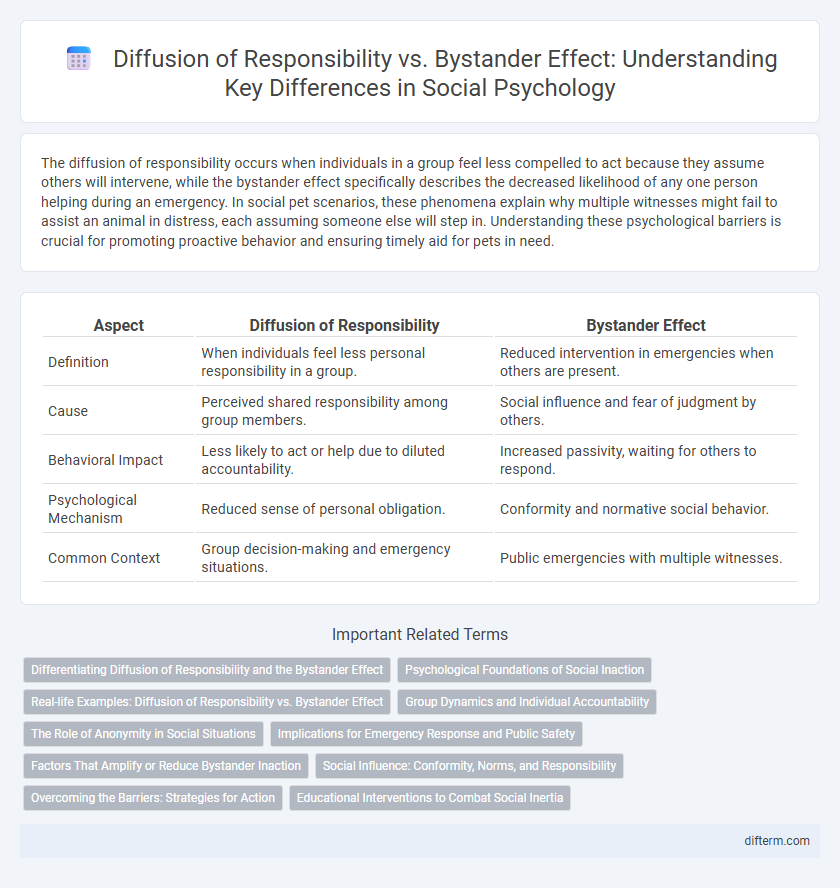The diffusion of responsibility occurs when individuals in a group feel less compelled to act because they assume others will intervene, while the bystander effect specifically describes the decreased likelihood of any one person helping during an emergency. In social pet scenarios, these phenomena explain why multiple witnesses might fail to assist an animal in distress, each assuming someone else will step in. Understanding these psychological barriers is crucial for promoting proactive behavior and ensuring timely aid for pets in need.
Table of Comparison
| Aspect | Diffusion of Responsibility | Bystander Effect |
|---|---|---|
| Definition | When individuals feel less personal responsibility in a group. | Reduced intervention in emergencies when others are present. |
| Cause | Perceived shared responsibility among group members. | Social influence and fear of judgment by others. |
| Behavioral Impact | Less likely to act or help due to diluted accountability. | Increased passivity, waiting for others to respond. |
| Psychological Mechanism | Reduced sense of personal obligation. | Conformity and normative social behavior. |
| Common Context | Group decision-making and emergency situations. | Public emergencies with multiple witnesses. |
Differentiating Diffusion of Responsibility and the Bystander Effect
Diffusion of responsibility occurs when individuals in a group feel less personally accountable for taking action, leading to decreased intervention. The bystander effect describes the phenomenon where the presence of multiple witnesses reduces the likelihood that any one person will help in an emergency. While both concepts explain reduced helping behavior, diffusion of responsibility specifically highlights a decrease in personal accountability, whereas the bystander effect emphasizes social influence and observation of others' behavior.
Psychological Foundations of Social Inaction
Diffusion of responsibility occurs when individuals in a group feel less personal accountability, leading to decreased likelihood of helping behavior, while the bystander effect describes the phenomenon where the presence of others inhibits intervention in emergency situations. Psychological foundations of social inaction reveal that ambiguity, social influence, and perceived evaluation apprehension contribute to both diffusion of responsibility and the bystander effect. Research in social psychology emphasizes cognitive mechanisms such as pluralistic ignorance and reduced perceived personal risk as critical factors underlying these phenomena.
Real-life Examples: Diffusion of Responsibility vs. Bystander Effect
In real-life situations, diffusion of responsibility occurs when individuals in a group feel less compelled to act, as seen in emergency scenarios where multiple witnesses fail to intervene. The bystander effect emerges prominently during public incidents like street assaults or medical emergencies, where the presence of others inhibits intervention due to social influence and fear of judgment. High-profile cases, such as the 1964 Kitty Genovese incident, illustrate both phenomena, emphasizing how group dynamics can suppress personal accountability and delay critical help.
Group Dynamics and Individual Accountability
Diffusion of responsibility occurs when individuals in a group feel less personal accountability, leading to decreased likelihood of helping behavior. The bystander effect specifically highlights how the presence of others inhibits individual intervention during emergencies, driven by ambiguous group roles and shared responsibility. Understanding these phenomena within group dynamics reveals the critical need for clear accountability to enhance individual action in social settings.
The Role of Anonymity in Social Situations
Anonymity significantly influences both diffusion of responsibility and the bystander effect by reducing personal accountability in social situations. When individuals perceive their actions as untraceable, they are less likely to intervene, increasing the likelihood of inaction despite others needing help. Research shows that decreased identifiability in crowds intensifies the bystander effect, as anonymity dilutes the sense of individual responsibility.
Implications for Emergency Response and Public Safety
The diffusion of responsibility reduces individual accountability, causing delayed or absent intervention during emergencies, while the bystander effect explains how the presence of multiple witnesses leads to decreased likelihood of action. Understanding these phenomena is crucial for designing public safety campaigns that emphasize personal responsibility and providing clear, specific instructions to onlookers. Training programs and emergency response protocols must incorporate strategies to counteract psychological barriers, ensuring timely assistance and improved community safety outcomes.
Factors That Amplify or Reduce Bystander Inaction
Factors that amplify bystander inaction include ambiguity of the situation, perceived personal risk, and the size of the witness group, which intensifies diffusion of responsibility and reduces the likelihood of intervention. Conversely, clear emergencies, direct appeals for help, and strong personal connections between bystanders and victims significantly reduce bystander effect by fostering accountability and empathy. Situational awareness and cultural norms promoting prosocial behavior also play crucial roles in mitigating diffusion of responsibility during critical social incidents.
Social Influence: Conformity, Norms, and Responsibility
Diffusion of responsibility reduces individual accountability in group settings, often diminishing the likelihood of intervention during emergencies, while the bystander effect highlights the decreased probability of helping as group size increases. Social influence, particularly conformity to group norms, shapes behavior by aligning individual actions with perceived collective expectations, reinforcing passivity in critical moments. Understanding how social norms and responsibility perceptions interplay is crucial for addressing collective inaction and promoting proactive helping behaviors.
Overcoming the Barriers: Strategies for Action
Overcoming the barriers of diffusion of responsibility and the bystander effect requires clear communication and designated roles to prompt individual accountability in group settings. Implementing training programs that emphasize social responsibility and the importance of immediate action significantly reduces hesitation in emergencies. Utilizing technological tools like alert apps can also facilitate faster responses by directly notifying specific individuals rather than diffusing the sense of responsibility among many.
Educational Interventions to Combat Social Inertia
Educational interventions targeting diffusion of responsibility effectively reduce social inertia by increasing individual accountability and awareness in group settings. Programs utilizing role-playing and scenario-based learning enhance empathy and prompt proactive helping behaviors, thereby mitigating the bystander effect. Incorporating these strategies into school curricula cultivates a culture of responsibility and collective action, essential for fostering social engagement and support networks.
diffusion of responsibility vs bystander effect Infographic

 difterm.com
difterm.com